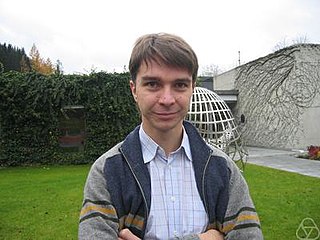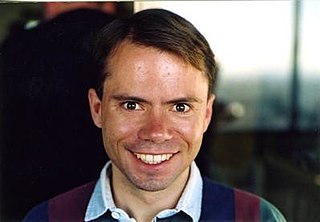
In physics and mathematics, the Lorentz group is the group of all Lorentz transformations of Minkowski spacetime, the classical and quantum setting for all (non-gravitational) physical phenomena. The Lorentz group is named for the Dutch physicist Hendrik Lorentz.

In mathematics, the conformal group of a space is the group of transformations from the space to itself that preserve angles. More formally, it is the group of transformations that preserve the conformal geometry of the space.

Bernard Morin was a French mathematician, specifically a topologist.

In mathematics, the representation theory of the Poincaré group is an example of the representation theory of a Lie group that is neither a compact group nor a semisimple group. It is fundamental in theoretical physics.
In mathematics, an atoroidal 3-manifold is one that does not contain an essential torus. There are two major variations in this terminology: an essential torus may be defined geometrically, as an embedded, non-boundary parallel, incompressible torus, or it may be defined algebraically, as a subgroup of its fundamental group that is not conjugate to a peripheral subgroup. The terminology is not standardized, and different authors require atoroidal 3-manifolds to satisfy certain additional restrictions. For instance:
In mathematics, a fundamental polygon can be defined for every compact Riemann surface of genus greater than 0. It encodes not only the topology of the surface through its fundamental group but also determines the Riemann surface up to conformal equivalence. By the uniformization theorem, every compact Riemann surface has simply connected universal covering surface given by exactly one of the following:

In physics, a symmetry of a physical system is a physical or mathematical feature of the system that is preserved or remains unchanged under some transformation.
Geometric modeling is a branch of applied mathematics and computational geometry that studies methods and algorithms for the mathematical description of shapes.
Conformal coating material is a thin polymeric film which conforms to the contours of a printed circuit board to protect the board's components. Typically applied at 25-250 μm(micrometers) thickness, it is applied to electronic circuitry to protect against moisture, dust, chemicals, and temperature extremes.
Gregory Francis Lawler is an American mathematician working in probability theory and best known for his work since 2000 on the Schramm–Loewner evolution.

Stanislav Konstantinovich Smirnov is a Russian mathematician currently working at the University of Geneva. He was awarded the Fields Medal in 2010. His research involves complex analysis, dynamical systems and probability theory.
John Lawrence CardyFRS is a British-American theoretical physicist at the University of California, Berkeley. He is best known for his work in theoretical condensed matter physics and statistical mechanics, and in particular for research on critical phenomena and two-dimensional conformal field theory.

Mathematical phenomena can be understood and explored via visualization. Classically this consisted of two-dimensional drawings or building three-dimensional models, while today it most frequently consists of using computers to make static two or three dimensional drawings, animations, or interactive programs. Writing programs to visualize mathematics is an aspect of computational geometry.
Lorentz is a surname and a given name.
Andrea Malchiodi is an Italian mathematician who is active in the fields of partial differential equations and calculus of variations, with several contributions to geometric analysis.

Scott Sheffield is a professor of mathematics at the Massachusetts Institute of Technology. His primary research field is theoretical probability.

Alexander Holevo(Russian: Алекса́ндр Семéнович Хóлево, also spelled as Kholevo and Cholewo) is a Soviet and Russian mathematician, one of the pioneers of quantum information science.
Spherical wave transformations leave the form of spherical waves as well as the laws of optics and electrodynamics invariant in all inertial frames. They were defined between 1908 and 1909 by Harry Bateman and Ebenezer Cunningham, with Bateman giving the transformation its name. They correspond to the conformal group of "transformations by reciprocal radii" in relation to the framework of Lie sphere geometry, which were already known in the 19th century. Time is used as fourth dimension as in Minkowski space, so spherical wave transformations are connected to the Lorentz transformation of special relativity, and it turns out that the conformal group of spacetime includes the Lorentz group and the Poincaré group as subgroups. However, only the Lorentz/Poincaré groups represent symmetries of all laws of nature including mechanics, whereas the conformal group is related to certain areas such as electrodynamics. In addition, it can be shown that the conformal group of the plane is isomorphic to the Lorentz group.

Tilla Weinstein was an American mathematician known for her mentorship of younger women in mathematics. Her research concerned differential geometry, including conformal structures, harmonic maps, and Lorentz surfaces. She taught for many years at Rutgers University, where she headed the mathematics department in the Douglass Residential College.
Ulrich Pinkall is a German mathematician, specializing in differential geometry and computer graphics.
This page is based on this
Wikipedia article Text is available under the
CC BY-SA 4.0 license; additional terms may apply.
Images, videos and audio are available under their respective licenses.








